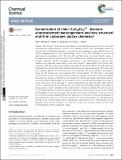Files in this item
Isomerisation of nido-[C2B10H12]2- dianions : unprecedented rearrangements and new structural motifs in carborane cluster chemistry
Item metadata
| dc.contributor.author | McKay, David | |
| dc.contributor.author | Macgregor, Stuart A. | |
| dc.contributor.author | Welch, Alan J. | |
| dc.date.accessioned | 2015-05-25T09:40:05Z | |
| dc.date.available | 2015-05-25T09:40:05Z | |
| dc.date.issued | 2015-05-01 | |
| dc.identifier | 178242949 | |
| dc.identifier | f9497a99-c9e0-4e86-a680-429e13e57e7b | |
| dc.identifier | 000353223100056 | |
| dc.identifier | 84928136333 | |
| dc.identifier.citation | McKay , D , Macgregor , S A & Welch , A J 2015 , ' Isomerisation of nido -[C 2 B 10 H 12 ] 2- dianions : unprecedented rearrangements and new structural motifs in carborane cluster chemistry ' , Chemical Science , vol. 6 , no. 5 , pp. 3117-3128 . https://doi.org/10.1039/C5SC00726G | en |
| dc.identifier.issn | 2041-6520 | |
| dc.identifier.other | RIS: urn:335A19A64394ED2AD542EF26FEE0B0D4 | |
| dc.identifier.other | ORCID: /0000-0003-0362-7848/work/29608114 | |
| dc.identifier.uri | https://hdl.handle.net/10023/6683 | |
| dc.description | We thank the EPSRC for support (DMcK funded by project EP/E02971X/1). | en |
| dc.description.abstract | Dianionic nido-[C2B10]2- species are key intermediates in the polyhedral expansion from 12- to 13-vertex carboranes and metallacarboranes, and the isomer adopted by these nido intermediates dictates the isomeric form of the 13-vertex product. Upon reduction and metallation of para-carborane up to five MC2B10 metallacarboranes can be produced (Angew. Chem., Int. Ed., 2007, 46, 6706), the structures of which imply the intermediacy of 1,7-, 3,7-, 4,7-, 7,9- and 7,10-isomers of the nido-[C2B10]2- species. In this paper we use density functional theory (DFT) calculations to characterise the reduction of closo-C2B10H12 carboranes and the subsequent isomerisations of the nido-[C2B10H12]2- dianions. Upon reduction para-carborane initially opens to [1,7-nido-C2B10H12]2- (abbreviated to 1,7) and [4,7-nido-C2B10H12]2- (4,7) and isomerisation pathways connecting 1,7 to 7,9, 4,7 to 7,10 and 1,7 to 3,7 have been characterised. For ortho- and meta-carborane the experimental reduction produces 7,9 in both cases and computed pathways for both processes are also defined; with ortho-carborane rearrangement occurs via 7,8, whereas with meta-carborane 7,9 is formed directly. The 7,9 isomer is the global minimum nido-structure. The characterisation of these isomerisation processes uncovers intermediates that adopt new structural motifs that we term basket and inverted nido. Basket intermediates feature a two-vertex basket handle bridging the remaining 10 vertices; inverted nido intermediates are related to known nido species, in that they have 5- and 6-membered belts, but where the latter, rather than the former, is capped, leaving a 5-membered open face. These new intermediates exhibit similar stability to the nido species, which is attributed to their relation to the 13-vertex docosahedron through the removal of 5-connected vertices. Isomerisation pathways starting from nido geometries are most often initiated by destabilisation of the cluster through a DSD process causing the 3-connected C7 vertex to move into a 4-connected site and a neighbouring B vertex to become 3-connected. The ensuing rearrangement of the cluster involves processes such as the pivoting of a 4-vertex diamond about its long diagonal, the pivoting of two 3-vertex triangles about a shared vertex and DSD processes. These processes are all ultimately driven by the preference for carbon to occupy low-connected vertices on the open 6-membered face of the resulting nido species. | |
| dc.format.extent | 11 | |
| dc.format.extent | 3339215 | |
| dc.language.iso | eng | |
| dc.relation.ispartof | Chemical Science | en |
| dc.subject | QD Chemistry | en |
| dc.subject | NDAS | en |
| dc.subject.lcc | QD | en |
| dc.title | Isomerisation of nido-[C2B10H12]2- dianions : unprecedented rearrangements and new structural motifs in carborane cluster chemistry | en |
| dc.type | Journal article | en |
| dc.contributor.institution | University of St Andrews. School of Chemistry | en |
| dc.identifier.doi | https://doi.org/10.1039/C5SC00726G | |
| dc.description.status | Peer reviewed | en |
| dc.identifier.url | http://www.rsc.org/suppdata/c5/sc/c5sc00726g/c5sc00726g1.mp4 | en |
| dc.identifier.url | http://www.rsc.org/suppdata/c5/sc/c5sc00726g/c5sc00726g2.mp4 | en |
| dc.identifier.url | http://www.rsc.org/suppdata/c5/sc/c5sc00726g/c5sc00726g3.mp4 | en |
| dc.identifier.url | http://www.rsc.org/suppdata/c5/sc/c5sc00726g/c5sc00726g4.pdf | en |
This item appears in the following Collection(s)
Items in the St Andrews Research Repository are protected by copyright, with all rights reserved, unless otherwise indicated.

